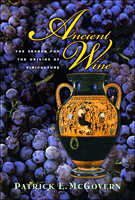
|
|
Books: Roots of the Vine
|
Volume 57 Number 2, March/April 2004
|
|
by Spencer P.M. Harrington
|
Did our prehistoric ancestors discover winemaking after observing robins, gorged on fermented grapes, falling off their perches? Or was the first winemaking accidental, with harvested grapes rupturing and fermenting to produce a crude but intoxicating Stone Age vintage? We're probably never going to know the answer, but Patrick E. McGovern's Ancient Wine: The Search for the Origins of Viniculture (Princeton: Princeton University Press, 2003; $29.95) takes a stab at it by showing how archaeologists are illuminating the early history of wine, often with little more evidence than residues on potsherds. McGovern, director of the Molecular Archaeology Laboratory at the University of Pennsylvania Museum, has been at the forefront of this research, studying Neolithic pottery for the presence of tartaric acid, a marker for wine.

McGovern proposes modern-day Georgia and Armenia as the likely sites of the domestication of the Eurasian wine grape some 8,000 years ago. Winemaking spread south from there, with wines being produced in northwestern Iran at Hajji Firuz Tepe by 5400 B.C. A little more than 4,000 years later, Near Eastern wine culture had evolved to the point where amphoras found in the palace of Amenhotep III in western Thebes noted vintage, quality, appellation, and even the purpose or occasion for the blend.
The book is most vivid when McGovern is relating his own research experiences--how he was able to determine that a grog of wine, beer, and mead was prepared for a royal funeral feast at Gordion in Turkey, or how he learned that jars in the tomb of the Egyptian king Scorpion I at Abydos contained resinated wine imported from the southern Levant. McGovern's research reveals that early wine was often mixed with tree resin. Since ancient cellar masters had no way of halting oxidation or inhibiting bacterial growth in their wine, they added the resin as a way of masking offensive tastes and smells. Greek retsina is a vestige of this tradition.
While McGovern goes a long way in fleshing out viniculture's murky prehistory, his descriptions of molecular archaeological techniques are too detailed for the general reader, and he is prone to digression. This makes Ancient Wine a hard slog for all but the most devoted wine geek or student of the past. Still, persistent readers will be rewarded with a deeper appreciation of their next bottle of wine, be it retsina or Pouilly-Fuisse.
Spencer P.M. Harrington is a wine consultant and former ARCHAEOLOGY senior editor.

© 2004 by the Archaeological Institute of America
archive.archaeology.org/0403/reviews/wine.html |

